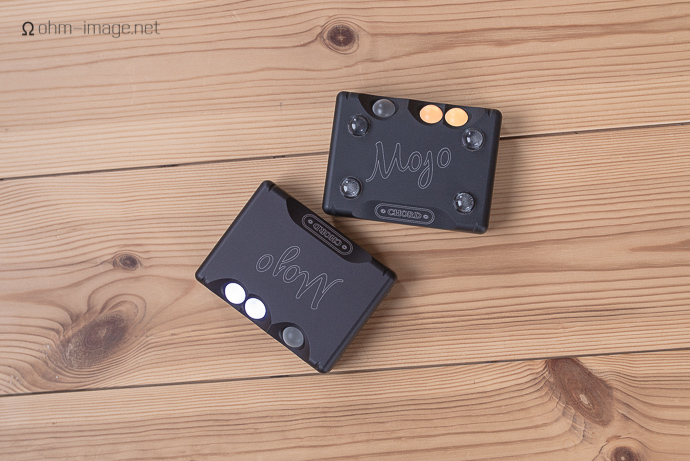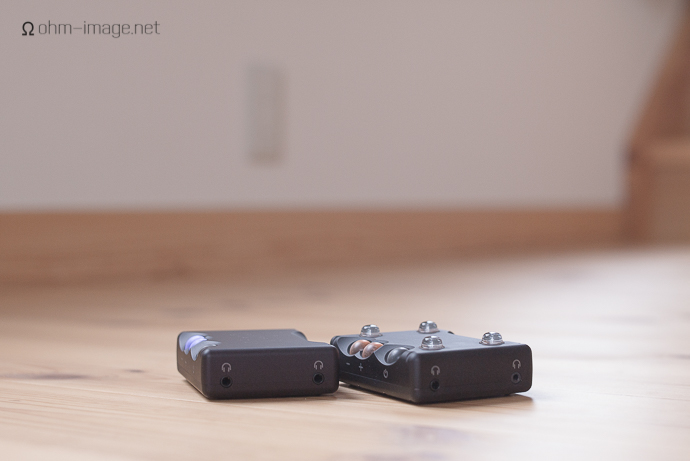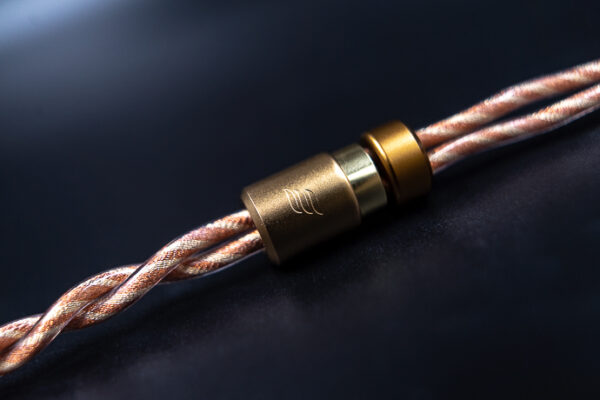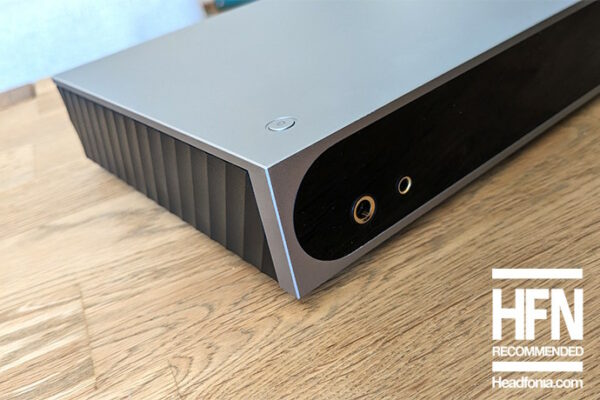Sound
In the absence of a great-performing one-box balanced solution there is Mojo-Kai. Let’s look at a some single-ended RMAA results:
Noise – Mojo-Kai: -115,9dB – – Mojo: -116,5dB
DR – Mojo-Kai: 115,6dB – – Mojo: 116,4dB
THD – Mojo-Kai: 0,0005% – – Mojo: 0,0002%
IMD – Mojo-Kai: 0,0009% – – Mojo: 0,0006%
Stereo crosstalk – Mojo-Kai: -114,9dB – – Mojo: -116,5dB
My regular Mojo measures better.
Loaded:
Noise – Mojo-Kai: -115,8dB – – Mojo: —116,6dB
DR – Mojo-Kai: 115,5dB – – Mojo: 116,4dB
THD – Mojo-Kai: 0,056% – – Mojo: 0,062%
IMD – Mojo-Kai: 0,101% – – Mojo: 0,110%
Stereo crosstalk – Mojo-Kai: -93,8dB – – Mojo: -93,7dB
Loaded, it is a wash. I can explain every result except for the narrow rift in unloaded stereo crosstalk:
Every Mojo I’ve used has tested differently. The first I tested returned results similar to my Mojo, but hissed like the Dickens. The second tested within 1,5dB of my current Mojo. Ryuzoh’s outputs 0,5dB less volume at the same maximum stable voltage setting. We should expect its results to stray from my unit by the same number. By and large they do. Only stereo cross talk challenges that assertion. At first I thought the anomalies came from my Lynx HILO. But, after extensive testing, re-testing, both on the day, and months later, my iPhone and iPod, for instance, reveals measured numbers that change by much smaller fractions, if at all. So if Lynx contributes at all to the differences, it is microscopically.
Back to Mojo and Mojo-Kai:
Loaded, the story is much the same, though unfavourable discrepancies appear in DR and Noise; favourable discrepancies appear in THD and IMD. For all intents and purposes, stereo crosstalk is the same.
Honestly, I can detect no audible difference between the two. If you’re not a balanced-out listener, stick with Mojo.
But Mojo-Kai isn’t about its single-ended output. If you’re parting with 45.000¥ for it, you’re a balanced headphone user. And in balanced, this mod really struts its stuff.

NOTE: Because Mojo-Kai’s balanced output gain has been lowered by 14dB, its maximum stere-stable voltage is lower; in this case, it tops out about where an iPhone 4s’s maximum volume does.
Noise – Mojo-Kai: -115,3dB – – Mojo: -111,4dB
DR – Mojo-Kai: 115,3dB – – Mojo: 111,1dB
THD – Mojo-Kai: 0,0003% – – Mojo: 0,0004%
IMD – Mojo-Kai: 0,0083% – – Mojo: 0,033%
Stereo crosstalk – Mojo-Kai: -115,4dB – – Mojo: -112,3dB
And here are loaded test results:
Noise – Mojo-Kai: -115,3dB – – Mojo: -111,3dB
DR – Mojo-Kai: 115,2dB – – Mojo: 111,1dB
THD – Mojo-Kai: 0,0029% – – Mojo: 0,014%
IMD – Mojo-Kai: 0,0083% – – Mojo: 0,033%
Stereo crosstalk – Mojo-Kai: -114,4dB – – Mojo: -93,8dB
Measurable gains show under every metric, both loaded and unloaded. Most of these I consider to be inaudible. A gain of ~30dB in stereo crosstalk, however, is something else. Of course, Mojo spitting 93dB into a notoriously hard-to-drive earphone, is impressive. But Mojo-Kai’s 114,4dB is insane.
Straight numbers don’t tell a great story. Mojo-Kai’s DR in frequencies from 10Hz to 70Hz, expands by 30dB to 10dB, respectively. And driving the SM2, Mojo-Kai achieves stereo separation in excess of -100dB is achieved from 100Hz to 1kHz. From there it runs straight and gentle to its nadir, at -90dB, where the regular Mojo clods off at -64dB.
Also, the strange frequency dip at the very top of the frequency spectrum when either Mojo or Mojo-Kai drives the SM2 is gone. That dip is roughly -1dB by 20kHz, and so, inaudible. But it’s gone.
Listening
One thing to note: because Mojo-Kai’s balanced gain has been lowered, you must remember a few things:
1. turn down the volume before switching to single-ended
2. despite ample current overhead, it doesn’t have the voltage to drive insensitive headphones to insane volume levels
Ryuzoh has a thing for FitEar earphones. So do I. What I love about the FitEar MH335DW is that it is sensitive but not overly prone to hiss, and only minimally accented toward the lower midrange. I don’t know if it is Ryuzoh’s Mojo, or his mod, but the Mojo-Kai he lent me hisses very slightly more than a regular Mojo. The difference is small but noticeable through earphones too sensitive for most of the market: Ultrasone IQ and Shure SE846. MH335DW hisses only barely through either Mojo.
At the ear, I reckon that the MH335DW sounds warmer single-ended than it does balanced. I don’t know if this has to do with its drivers and crossovers being wired for single-ended. Perhaps, it is because when balanced, its load is effectively lightened. Whatever the case, to my ears, balanced MH335DW is lighter, sprier, and in my opinion, more neutrally mated to trance and EDM where tidiness and space are personally paramount.
I notice the same thing through Ultrasone’s IQ. Drier, wider, and tidier. I would accept the charge of placebo as I have no way to properly blind ABX earphones, especially when such a decibel gap exists between the two outputs. But that is what I hear.

End words
Whatever the case, Mojo-Kai is especially well suited to earphones. If you’re a balanced earphone user worried by the shameful output of your DP-X1 and AK380, not to mention Opus#1, Mojo-Kai is your best bet. It plays nice with any device with USB protocol, and thanks to transformer coupling, is less susceptible to RF interference through coaxial input (tested with Lynx HILO with nearby iPhone 6). It is a good design. It is, in fact, a design that makes more sense to me than the stock Mojo, whose second output is redundant.
And, whether or not Mojo-Kai is unseated by upcoming mods (doubtful), it speaks volumes about Mojo’s modularity. By no means is Mojo an analogue to the mid-1990s’ Honda’ Civic, a veritable modding champ. It is a high-end portable DAC. But it can be modded. Ryuzoh says that he can plug a heat sink onto its FPGA to further stabilise its outputs.
Stock, Mojo is world’s better than most of the competition. If you’re okay to pay for balanced, Ryuzoh’s mods take it to another level.








Barun C
An of the ball article, very enjoyable indeed Nathan. I myself am skeptical about balanced DAPs. Last month I tried the AK 240, and I have to say the balanced mode didn’t impress me that much. I was using the JH Audio Angie’s and the only difference I found was in the increase overall volume levels with a touch of clarity in the sound stage and thats it.
Through balanced headphone output of amps like EF6 (Desktop) and iBasso Pelican 2 (Portable), the balanced made some sort os sense to me as the headphones being put were inefficient & power hungry. For IEM’s I really don’t get the point still. The most power hungry IEM I have is the Ocharaku Nami and they really benefit from amplification, although they are not available in balanced version.
ohm image
Balanced DAPs are as of today, worthless in their promise to deliver balanced audio – at least as it pertains to the benefits of balanced signals: lower noise, higher dynamic range, etc., from a device with the same power spec.
DP-X1 can’t properly drive an earphone, and the AK380 is disgusting. The Opus#1 is not terribly high quality. This mod delivers all that a balanced signal is capable of and does it to the hardest current-to-voltage devices around: balanced armature earphones.
I’m not one to get into balanced audio, but this mod is very good.
Chris
Balanced design puts a lot of stress on the engineering and manufacturing end. I don’t think under this economy they will be able to make it work well as an entire product. My UD-503 does the amp well but the dac part has a LOT of glitches.
Barun C
Seems so. I wonder what Chord will do with the announced add on modules to the Mojo, increase battery life and power may be.
Newbie
Curious if anyone has used this with poly.
rob l
To me, the blame goes squarely onto the 2.5 balanced output standard. It sucks.
I had the AK240 paired with Noble Encore using the 2.5 balanced and went back to 3.5 unbalanced because it sounded better in every way, especially in the bass impact department.
However, once you 4.4mm – you will not go back. This is better in every way v 2.5, without loosing impact, and improving pretty much everywhere else in the spectrum. I have the Mojo and i use it with the Meze Classic 99 and it’s awesome, but i would never chance potentially creating other issues with my perfect Mojo in pursuit of what i feel is really, a downgrade.
Personally if you going for balanced and you haven’t heard 4.4 standard, you owe to your self to check it out before spending on any balanced standard at all.
ohm image
There’s nothing wrong with the 2,5mm standard apart from longevity. It has no more or less objective problems or superlatives regarding measurable sound quality than 4,4. It is however far more prone to breakage and shorting. 4,4 is far sturdier.